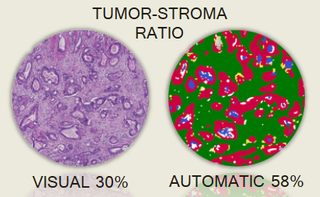Computer aided quantification of TSR as independent prognosticator in rectal cancer

Tumor-stroma ratio (TSR) serves as an independent prognostic factor in colorectal cancer. The recent introduction of digital pathology in routine tissue diagnostics holds opportunities for automated TSR analysis. Oscar Geessink and colleagues investigated the potential of computer-aided quantification of intratumoral stroma in rectal cancer whole-slide images. Hot-spots inside histopathological slides of 129 rectal adenocarcinoma patients were visually assessed for TSR by two experts. A semi-automatic method based on deep learning was trained to segment all relevant tissue types in rectal cancer histology and subsequently applied to the hot-spots provided by the experts. Patients were assigned to a ‘stroma-high’ or ‘stroma-low’ group by both TSR methods (visual and automated). With stroma-low as baseline, automated TSR was found to be prognostic independent of age, gender, pT-stage, lymph node status, tumor grade, and whether adjuvant therapy was given, both for disease-specific survival (hazard ratio = 2.48 (95% confidence interval 1.29–4.78)) and for disease-free survival (hazard ratio = 2.05 (95% confidence interval 1.11–3.78)). Visually assessed TSR did not serve as an independent prognostic factor in multivariate analysis. This work has been accepted for publication by Celullar Oncology, and appeared online this month.
← Back to overview